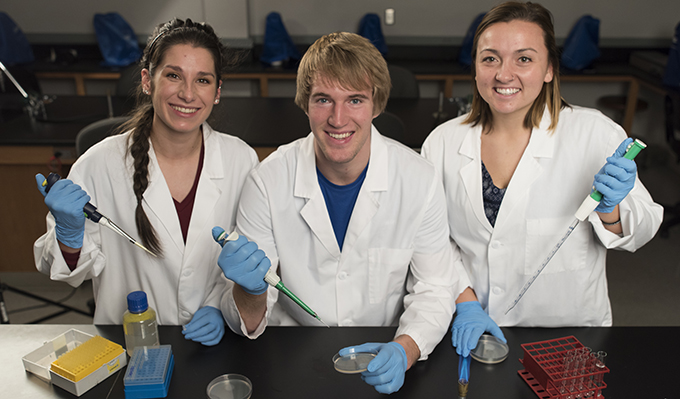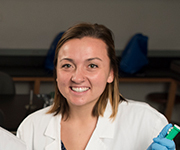More Than Just a Phage
National program gives Northwestern students experience in contributing to groundbreaking scientific research
BY ANITA CIRULIS

DOUG BURG
Sabrina Tarchione, Chris Borchers and Courtney Mithelman (from left) are among the Northwestern students who have benefited from Northwestern’s participation in a program that provides real, discovery-based research experience to undergraduates.
A national program designed to interest undergraduates in scientific research is doing just that at Northwestern. Students are part of a global effort to discover phages, which are viruses that infect bacteria—in this case, bacteria that live in soil.
“I learn so much more when I actually do the research myself,” says Courtney Mithelman, a junior majoring in genetics, molecular and cellular biology. Mithelman initially decided to become a genetic counselor after Jason Flanagan ’00, a genetic counselor at Sanford Health in Sioux Falls, spoke to her class. Now she’s thinking about other options. “I’ve definitely considered what research would be like as a career,” she says.
Chris Borchers, a biology-health professions junior, chose Northwestern because of its academic reputation and strength in the sciences. He, too, is now open to the possibility of doing research. He also cites another benefit of the program: a more impressive résumé. He and other students enrolled in Genetics this past fall will be co-authoring genome announcements for publication in a journal of the American Microbiological Society and posters for presentation at a national symposium and at the Iowa Academy of Science.
“That’s really important because when students apply for internships, graduate school or medical school, the people reviewing those applications are looking for research experience,” says Dr. Sara Sybesma Tolsma ’84, professor of biology. “And if a student has published research, that shows their work has been peer-reviewed and found worthy.”
SELECT COMPANY
Tolsma led Northwestern’s application process for SEA-PHAGES, a program run by the Science Education Alliance (SEA) of the Howard Hughes Medical Institute. Northwestern was one of just 20 colleges and universities in the U.S. chosen to join the program in 2016–17. Nationwide, more than 100 colleges and universities participate in SEA-PHAGES. Since the program was launched nine years ago, over 16,000 college students have contributed to the exploration of microbial diversity by discovering nearly 9,000 bacteria-infecting viruses. SEA-PHAGES provides weeklong training sessions for faculty and pays for the cost of sequencing the DNA genomes of two phages per institution per year.
Northwestern is unique among participating schools in its approach to the SEA-PHAGES program. Rather than offer a single SEA-PHAGES course, Tolsma and her colleagues have embedded the research into three sequential courses. Students begin by taking General Biology their first year with Dr. Laurie Furlong, where they are introduced to the SEA-PHAGES program and collect soil samples from a variety of sites.
In Microbiology, taught by Dr. Byron Noordewier, students isolate the viruses from the soil samples using a host bacterium. The phages are then purified and their DNA isolated and compared. The final step is to image the phages using a transmission electron microscope at the University of Iowa and enter information about the viruses into a database supported by the SEA-PHAGES project.
The two highest-quality DNA samples are then sent to the University of Pittsburgh for sequencing. When those sequencing results are returned to Northwestern, students enrolled in Genetics, the third SEA-PHAGES course taught by Tolsma, work in teams to annotate the DNA, identifying the locations of individual genes and determining what the genes’ protein products do.
PROVEN SUCCESS

Northwestern students hunting for bacteriophages in soil have discovered new bacteria-infecting viruses. Roots515, isolated and named by Courtney Mithelman, has a short, stubby tail and infects mycobacteria.
Northwestern’s biology professors are convinced the three-course sequence is a wise approach to teaching students research techniques. At a recent multi-college SEA-PHAGES annotation event, Northwestern’s participants demonstrated an impressive ability to do the gene annotation.
“Because our students were juniors and seniors instead of second-semester freshmen, they had a greater understanding of biology—and that made the annotation experience more meaningful and of higher quality,” Tolsma explains.
Noordewier likewise has evidence of how well Northwestern’s students are prepared to do research. He secured a grant that helped pay a portion of the cost for him to take students to the University of Iowa to use its electron microscope. “The students were real impressive at that point,” Noordewier says, “so I was invited to present about Northwestern’s SEA-PHAGES program at the fall meeting of the Iowa Microscopy Society.”
Estimates place the number of phages on our planet at 1031—a quantity that is almost impossible to comprehend. Phages are helping scientists understand life and develop new medical treatments. Thanks to the SEA-PHAGES program, Tolsma says, “Not only is science advancing because we know more about these phages, but there’s an army of undergraduates who are getting trained as scientists.” 
What’s In a Name?
Every student in Northwestern’s Microbiology class discovered a phage. As part of that discovery process, they named their phages, which Courtney Mithelman says was harder than she expected. “You want to be funny or clever while also being original,” she explains.
Mithelman named her phage Roots515 because 515 is the area code for Des Moines, where her home is. Chris Borchers, a member of Northwestern’s men’s basketball team, used his initials and uniform number to create Cborch11. And Sabrina Tarchione, the third student whose phage’s DNA was sequenced by the University of Pittsburgh, chose her first initial and those of her siblings, along with the total number of people in her family. The result: Sibs6.
Phages are classified into clusters and subclusters based on the similarity of their DNA. Of the three sequenced phages Northwestern got back from Pitt, Borchers hit the jackpot. “There have only been six H1 phages discovered,” Tolsma says. “Chris’s is No. 6. And of those six, four have been annotated, so ours will be the fifth.”
 A research interest that started at NWC has led to psychology professor Amanda Brouwer’s first book and offers help for those who want to get healthy and stay that way.
A research interest that started at NWC has led to psychology professor Amanda Brouwer’s first book and offers help for those who want to get healthy and stay that way. Participation in pioneering study helps Northwestern students explore careers as research scientists.
Participation in pioneering study helps Northwestern students explore careers as research scientists. Alumni share stories about the best things they found in their campus mailbox.
Alumni share stories about the best things they found in their campus mailbox. 6 Questions with Scott Simmelink
6 Questions with Scott Simmelink
Classic Comments
All comments are moderated and need approval from the moderator before they are posted. Comments that include profanity, or personal attacks, or antisocial behavior such as "spamming" or other inappropriate comments or material will be removed from the site. We will take steps to block users who violate any of our terms of use. You are fully responsible for the content that you post. Comments posted do not reflect the views or values of Northwestern College.